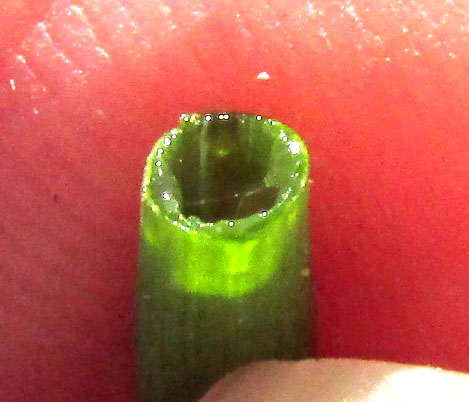Excerpts from Jim Conrad's
Naturalist Newsletter
entry dated January 5, 2023, issued from near Tequisquiapan, elevation about 1,900m (6200 ft), ~N20.57°, ~ W99.89°, Querétaro state, MÉXICO
CHIVES FLOWERING

About a month ago I broke apart a pot of chives that had become root-bound, and transplanted them to a larger pot. Now some are flowering and I'm unsure whether it's because of the transplanting, the days beginning to get longer, or maybe here in central Mexico they flower anytime. We have irises flowering, too, though they might blossom anytime during the year. I read that in the US chives bloom in mid spring to early summer. Here it feels like spring all the time.

We've seen that in the Yucatan the Maya traditionally grow a certain kind of white-flowered chives I call Maya Chives because it's different from most chives profiled on the Internet, and in the Yucatan we've found several cultivars that seem to be Maya specialties. These chives in central Mexico, given to me by a friend in Tequisquiapan, are very different from our white-flowered Yucatan ones. Chives are onions of the genus Allium, of which at this time the GBIF.Org portal recognizes 1,235 species, so, which is this one?
Above you can see that our central Mexican chives' pink flowers gather atop their stem, or scape, in an umbel-type flower cluster, which is typical of all Allium species, except for those for which flowers are replaced by small, onion-like vegetative bulbs. Here's a look inside of single flower:

Each of our plant's flowers produces 6 petal-like tepals, the term tepal used when there's no clearly identifiable calyx sepals and corolla lobes or petals. Opposite each tepal arises a stamen, in contrast to the more typical arrangement of stamens alternating with flower parts. The stamen's stem-like filaments broaden at their bases and fuse, forming a kind of ring or rim around the ovary's base. The ovary is three-lobed. All these details are typical of the genus Allium, so none except for the flower color helps much with identification. With onion species, vegetative features provide the main field marks for identification. Here's a good one helping us zero in on the species:

Many onion species produce flat or solid stems, so this hollow, cylindrical feature helps a lot. Other important field marks are seen with the plant's bulbs:

First, they're small, just 3-4mm across, plus they're elongate instead of egg-shaped to spherical, and they're clumped. The bulbs of many species don't clump. Also, the bulbs' outer coats are like semitransparent cellophane, or membranous, while the bulb coats of many onion species consist of a sometimes brown, fibrous network, or reticulum.
All these features appear to lead to the species that most people are talking about when they refer simply to Chives -- ALLIUM SCHOENOPRASUM. Often the species is called Wild Chives, because its distribution is "circumboreal," meaning that it occupies habitats worldwide in the northern half of the planet, especially cooler ones, and especially wet meadows, rocky or gravelly stream banks, and lake shores. It's native to North America, but often escapes, and often it's impossible to say whether a population is natural or consists of escaped garden plantings.
Also, it's an extremely variable, or polymorphic, species, and throughout its distribution area both large and small races occur. We seem to have a small race, our plant's blades averaging maybe 10cm long (0.4 inch). Several attempts have been made to designate varieties or subspecies of Allium schoenoprasum. However, the Flora of North America says, "Until the variation can be worked out along natural lines, if any, instead of unstable features such as plant size, and color and shape of the tepals, recognition of these varieties is unsound."
So, Chives. Here we just have Chives, surely Allium schoenoprasum. It's a small race of Chives, maybe too small to be of much use in salads unless you have a great many of them, which I may have after a few more years of breaking and transplanting. Until then, their cheerful greenness and those pretty, pink flowers are very agreeable to see, and I'm grateful to my friend for that first little pot of them.